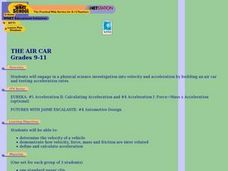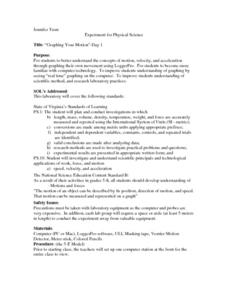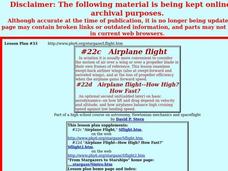Curated OER
A Moving Experience - Forces and Inertia
Students consider the first part of Newton's First Law of Motion, the Law of Inertia of objects at rest, which states that every object remains at rest unless acted on by a force. They perform hands-on experiments which demonstrate this...
Curated OER
Atoms, Molecules and Ions
Atomic theory, experiments that contributed to our knowledge of matter, atomic structure, isotopes, and ions are covered in these 33 slides. Quality diagrams and labeled charts will help activate understanding. The presentation concludes...
Curated OER
Magnetic Fields and Forces Homework/Electromagnetic Induction Homework
Here are two electromagnetism homework assignments rolled into one. The first eight practice problems deal with the magnetic field and magnetic force exerted by current-carrying wires. The second set of seven problems are specific to...
Curated OER
Observation and Inference
Assess your young scientists' understanding of the difference between observation and inference with this 20-question multiple choice quiz. It reviews a variety of physics and astronomy concepts, such as solar eclipses and sunspots, the...
Bowels Physics
Magnetic Fields and Forces
Every knows that opposites attract! Here's a presentation that uses this background knowledge to explain magnetic fields and forces. The resource also explains the shape of magnetic fields and how to determine the direction of forces.
Perkins School for the Blind
Friction
Friction is a force that can be felt, which means that learners with visual impairments can experiment to feel and understand the concept of friction. They slide a rock along a smooth table, and then they slide a rock across sandpaper,...
Curated OER
Motion Graphs
In this motion graphs activity, learners learn about how motion of objects can be described using a graph. Students then answer 10 fill in the blank, 10 short answer, and 5 problems to solve.
Curated OER
Newton: Force and Motion
In this forces worksheet, learners use the equations for acceleration and Newton's second law to learn about different motions and forces. This worksheet has 7 problems to solve.
Curated OER
The Air Car
Students, in groups, design and construct an air car capable of acceleration. They view a video on acceleration, test their cars and make adjustments as desired.
Curated OER
Understanding Symbols
In this symbols worksheet, students read about how different symbols are used to represent variables or constants in equations. Then students complete 3 problems.
Curated OER
The Bernoulli Effect - Conceptually
Students observe and/or conduct five experiments which address the Bernoulli Effect. For this conceptual lesson based on the Bernoulli Effect, the students construct atomizers, and make concrete observations and inferences in connection...
Curated OER
The Math Reaction
Students use the reaction time to figure out problems. They use the following example to get them started with reaction time: the edge of a ruler is placed near a person's thumb and index finger and, without warning, the ruler is...
Curated OER
TE Lesson: Kinetic and Potential Energy of Motion
Young scholars investigate the difference between potential and kinetic energy. They examine the formulae associated with both types of energy. They complete how quickly a pendulum with swing by converting potential energy into kinetic...
Curated OER
Forces
In this forces worksheet, students read about what affects the force on an object. Students identify push forces and pull forces in 5 diagrams. They answer 13 questions about the forces in two diagrams and they draw vector diagrams to...
Curated OER
Acceleration 1
In this acceleration worksheet, students use weights to increase the mass affecting the force on moving objects. Students plot a graph of their data and answer 3 questions about how the acceleration of the toy skateboard used in the...
Teach Engineering
Measuring Viscosity
Groups use a marble to determine the viscosity of household fluids. The procedure calls for pupils to measure the amount of time it takes a marble to fall a specified distance in the fluids. Using unit conversions and algebra, the teams...
Teach Engineering
Microfluidic Devices and Flow Rate
When you have to flow, you have to flow. The lesson introduces class members to microfluidic devices and their uses in medicine. They watch a short video on how the diameter affects the rate of flow. The worksheet has individuals...
Curated OER
Boarding School
Students discuss conservation of energy using a skateboarder in the halfpipe or a person on a roller coaster as an example. Using mathematical equations, students examine potential and kinetic energy of the examples. Lesson is completed...
Curated OER
Newton's Laws of Motion Crossword
In this Newton's Laws of Motion crossword puzzle instructional activity, students use the 13 clues and the terms in the word bank to help them correctly complete the word puzzle.
Curated OER
Newton's Laws of Motion
Ninth graders utilize Newton's Laws of Motion to explain how things move, create poster illustrating each law of motion, and present and explain their poster to classmates.
Curated OER
Newton's Laws of Motion
In this word search worksheet, students explore words relating to Newton's Laws of Motion. Students find thirteen words relating to Newton's laws of motion.
Curated OER
#22c Airplane flight #22d Airplane flight--How High? How Fast?
Pupils discuss the application of frames of reference to an airplane flying with a constant velocity v through the air.
Curated OER
Graphing Your Motion-Day 1
Ninth graders explore the concepts of motion, velocity and acceleration through graphing their own movement using LoggerPro. They become more familiar with the computer technology. Students explore graphing in real time and graph on...
Curated OER
Airplane flight
High schoolers learn the basic concepts about airplane flight. They learn the reason jetliner wings are swept back and why jet engines have replaced propellers in high-speed flight.

























